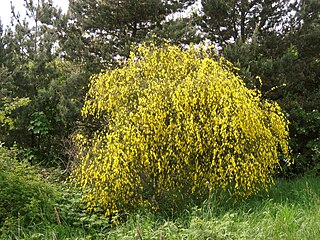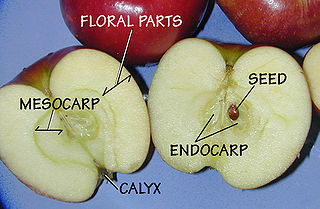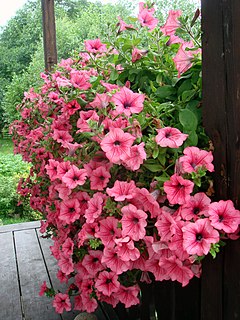
Buddleja, or Buddleia, commonly known as the butterfly bush, is a genus comprising over 140 species of flowering plants endemic to Asia, Africa, and the Americas. The generic name bestowed by Linnaeus posthumously honoured the Reverend Adam Buddle (1662–1715), an English botanist and rector, at the suggestion of Dr. William Houstoun. Houstoun sent the first plants to become known to science as buddleja to England from the Caribbean about 15 years after Buddle's death.

The Missouri Botanical Garden is a botanical garden located at 4344 Shaw Boulevard in St. Louis, Missouri. It is also known informally as Shaw's Garden for founder and philanthropist Henry Shaw. Its herbarium, with more than 6.6 million specimens, is the second largest in North America, behind only that of the New York Botanical Garden.

Quercus petraea, commonly known as the sessile oak, Cornish oak, or durmast oak, is a species of oak tree native to most of Europe and into Anatolia and Iran.

The Royal Botanic Garden Edinburgh (RBGE) is a scientific centre for the study of plants, their diversity and conservation, as well as a popular tourist attraction. Founded in 1670 as a physic garden to grow medicinal plants, today it occupies four sites across Scotland — Edinburgh, Dawyck, Logan and Benmore — each with its own specialist collection. The RBGE's living collection consists of more than 13,302 plant species, whilst the herbarium contains in excess of 3 million preserved specimens.

Viminaria juncea is the single species in the genus Viminaria endemic to Australia. The genus is in the pea family Fabaceae. It is colloquially known as native broom after its resemblance to the related European broom plants. The Noongar peoples know the plant as koweda.

Cotoneaster is a genus of flowering plants in the rose family, Rosaceae, native to the Palaearctic region, with a strong concentration of diversity in the genus in the mountains of southwestern China and the Himalayas. They are related to hawthorns (Crataegus), firethorns (Pyracantha), photinias (Photinia) and rowans (Sorbus).

Alchemilla mollis, the garden lady's-mantle or lady's-mantle, is an herbaceous perennial plant native to southern Europe and grown throughout the world as an ornamental garden plant. It grows 30 to 45 cm tall, with leaves that are palmately veined, with a scalloped and serrated margin. The stipules are noteworthy in that they are fused together and leaf like. The chartreuse yellow flowers are held in dense clusters above the foliage. This plant, together with a similar but dwarf variety, A. erythropoda, has gained the Royal Horticultural Society's Award of Garden Merit. The plant self-seeds freely and can become invasive.

Ornithogalum umbellatum, the garden star-of-Bethlehem, grass lily, nap-at-noon, or eleven-o'clock lady, is a perennial bulbous flowering plant, native throughout most of southern and central Europe, north-western Africa and south-western Asia. In North America, it has escaped its cultivation as a garden ornamental and can be found in many areas.

Sedum telephium, often called Hylotelephium telephium, orpine, livelong, frog's-stomach, harping Johnny, life-everlasting, live-forever, midsummer-men, Orphan John, witch's moneybags is a succulent perennial groundcover of the family Crassulaceae native to Eurasia. The flowers are held in dense heads and can be reddish or yellowish-white. A number of cultivars, often with purplish leaves, are grown in gardens as well as hybrids between this species and the related Hylotelephium spectabile (iceplant), especially the popular 'Herbstfreude'. Occasionally garden plants may escape and naturalise as has happened in parts of North America as wildflowers.

Pyracantha koidzumii commonly known as Formosa firethorn or Taiwan firethorn, is a species of plant in the family Rosaceae. It is threatened by habitat loss.

Gypsophila repens, known as alpine gypsophila or creeping baby's breath, is a species of flowering plant of the family Caryophyllaceae, native to the mountains of central and southern Europe, where it grows on dry, chalky slopes. The Latin name literally means "creeping chalk-lover". It is a prostrate, mat-forming herbaceous perennial, growing around 20 cm (8 in) tall by 30–50 cm (12–20 in) wide. For much of the summer it bears masses of star-shaped flowers which may be white, lilac or light purple, in loose panicles.

Pyracantha angustifolia is a species of shrub in the rose family known by the common names narrowleaf firethorn, slender firethorn and woolly firethorn. The flowers are white and produce small round pomes and can be orange to red in color. These fruits are astringent and bitter, making them inedible for humans, but they are a food source for birds. The leaves, fruit and seeds contain hydrogen cyanide, the source of the bitter taste. The stems and branches have sharp spines. This shrub is cultivated and grown in yards and gardens as an ornamental plant. It can be used to make hedges for home security. This species is native to China but has been introduced to North America. It is an invasive species in Hawaii and in other areas.

Pyracantha coccinea, the scarlet firethorn is the European species of firethorn or red firethorn that has been cultivated in gardens since the late 16th century. The tree has small white flowers. It produces small, bright red berries. The fruit is bitter and astringent, making it inedible when raw. The fruit can be cooked to make jellies, jams, sauces and marmalade. It ranges from southern Europe to western Asia. It has been introduced to North America and cultivated there as an ornamental plant since the 18th century.

Pyracantha crenatoserrata is a species of Firethorn. It is a short shrub. It is cultivated for its decorative bright red pome fruit. The flowers are white. It survives in warm climates. It cannot tolerate frost, but it can withstand drought. This species originates from central China.

Pyracantha crenulata, the Nepalese firethorn, Nepal firethorn or Himalayan firethorn, is a species of firethorn. It is cultivated as an ornamental plant. The leaves are used to make herbal tea. The wood can be used to make walking sticks. The pome fruit is orange-red and are food for birds.
Pyracantha rogersiana, the Asian firethorn, is a species of flowering plant in the family Rosaceae, native to western China. Growing to 4 metres (13 ft) tall and broad, it is an evergreen shrub with glossy, narrow leaves, and masses of white flowers followed by small yellow berries 8 mm in diameter. It is grown in gardens, yards, and parks, where it can be used as hedging, wall cover, or in a mixed shrub border. The cultivar 'Flava' has gained the Royal Horticultural Society's Award of Garden Merit.

Kew Gardens is a botanical garden in southwest London that houses the "largest and most diverse botanical and mycological collections in the world". Founded in 1840, from the exotic garden at Kew Park in Middlesex, England, its living collections include more than 30,000 different kinds of plants, while the herbarium, which is one of the largest in the world, has over seven million preserved plant specimens. The library contains more than 750,000 volumes, and the illustrations collection contains more than 175,000 prints and drawings of plants. It is one of London's top tourist attractions and is a World Heritage Site.

The firethorn leaf miner is a moth of the family Gracillariidae. It is native to southern Europe and was probably introduced accidentally into several countries in western Europe on transported plant material. It has now been recorded as far north as Finland and east to Hungary. It was first recorded in Great Britain in 1989. Nash et al. (1995) studied the spread of this species in Great Britain. Besides the "natural" spread of the insect, they found several foci of colonization outside the main distribution range that were undoubtedly due to human activities.

Semmozhi Poonga is a botanical garden in Chennai set up jointly by the Horticulture and Agricultural Engineering department of the Government of Tamil Nadu. The garden was opened on 24 November 2010 by then chief Minister Dr.M. Karunanidhi and is the first botanical garden in the city. The garden is located in the Cathedral Road–Anna Salai junction, opposite the American Consulate, on the erstwhile Drive-in Woodlands Hotel. Encompassing an area of 20 acres, it was built at a cost of ₹ 80 million. More than 500 species of plants are being grown in the area, in addition to the 80 trees that was already in existence during the development of the park, some of them being more than 100 years old. The garden houses some of the popular exotic flora and rare plant species, medicinal and aromatic herbs. Many of the exotic plants are imported from countries like China and Thailand, including a plethora of bonsai varieties of ficus microcarpa and ficus ginseng.
























